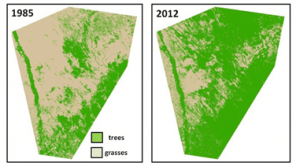Recent analysis of long-term satellite imagery across the hirola’s native range, revealed a nearly 300% increase of tree cover in the last 27 years (Figure below).

The figure shows changes in tree cover across the hirola’s historic range from 1985 to 2012.
Green represents tree cover and brown represents grasslands. The linear narrow band is the Tana River (the longest river in Kenya). Note the stark decrease in grassland between 1985 and 2012. The increase in tree cover poses one of the greatest threats to the survival of hirola populations through food limitation.
If this trend is not reversed, recovery of the hirola will become insurmountable.
The Solution
Our ten-year restoration project aims at restoring grasslands in areas where the hirola persist currently. As well as future reintroduction of sites through bush clearing and grass reseeding, which we anticipate will have the knock-on benefit of improving local livelihoods.
To restore the grassland habitats, we are implementing the following practices:
- The physical cutting, uprooting or breaking of branches in an attempt to restore grassland on a scale of hundreds of hectares in designated priority areas within the hirola range.
- The planting of native grass seeds on a scale of hundreds of hectares.
- Community-based protection of elephants (in the form of anti-poaching squads and enhanced communication between villages) to encourage elephant herds to reside within the community lands. In addition to hirola, we suspect that a suite of other wild ungulates will benefit from these attempts to improve range cover.
Arawale Reinstatement
The hirola conservation program is taking the lead in reinstating and restoring Arawale National reserve for the conservation of hirola in collaboration with Garissa County Government. The reserve was established in 1973 but operations were short lived due to persistent misunderstandings between local communities and the authorities.
Consequently, the protection and management of the reserve was halted by late 1980's. Subsequently, the hirola experienced a decline in population of 95% leading to them being listed as a Critically Endangered Species in 1996. Until we started our work in 2012, the Arawale National reserve lacked formal protection and management.
